Ashby Computers and Graphics Limited, trading as Ultimate Play the Game, was a British video game developer and publisher, founded in 1982, by ex-arcade video game developers Tim and Chris Stamper. Ultimate released a series of successful games for the ZX Spectrum, Amstrad CPC, BBC Micro, MSX and Commodore 64 computers from 1983 until 1987. Ultimate are perhaps best remembered for the big-selling titles Jetpac and Sabre Wulf, each of which sold over 300,000 copies in 1983 and 1984 respectively, and their groundbreaking series of isometric arcade adventures using a technique termed Filmation. Knight Lore, the first of the Filmation games, has been retrospectively described in the press as "seminal ... revolutionary" (GamesTM), "one of the most successful and influential games of all time" (X360), and "probably ... the greatest single advance in the history of computer games" (Edge).
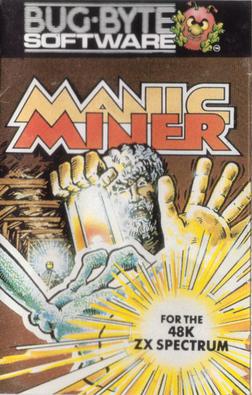
Manic Miner is a platform game written for the ZX Spectrum by Matthew Smith. It was published by Bug-Byte in 1983, then later the same year by Software Projects. The first game in the Miner Willy series, the design was inspired by Miner 2049er (1982) for the Atari 8-bit computers. Retro Gamer called Manic Miner one of the most influential platform games of all time, and it has been ported to numerous home computers, video game consoles, and mobile phones.

Sabre Wulf is an action-adventure game released by British video game developer Ultimate Play the Game for the ZX Spectrum home computer in 1984. The player navigates the pith-helmeted Sabreman through a 2D jungle maze while collecting amulet pieces to bypass the guardian at its exit. The player does not receive explicit guidance on how to play and is left to decipher the game's objectives through trial and error. Sabreman moves between the maze's 256 connected screens by touching the border where one screen ends and another begins. Each screen is filled with colourful flora, enemies that spawn at random, and occasional collectibles.

Jetpac is a shooter video game developed and published by Ultimate Play the Game and released for the ZX Spectrum and VIC-20 in 1983 and the BBC Micro in 1984. It is the first game to be released by Ultimate Play the Game, the company which later became Rare. The game follows Jetman as he must rebuild his rocket in order to explore different planets, while simultaneously defending against hostile aliens. It was written by Ultimate co-founder Chris Stamper with graphics designed by his brother, Tim Stamper. Reviewers praised Jetpac's presentation and gameplay, and it won "Game of the Year" at the Golden Joystick Awards in 1983.

Knight Lore is a 1984 action-adventure game developed and published by Ultimate Play the Game, and written by company founders Chris and Tim Stamper. The game is known for its use of isometric graphics, which it further popularized in video games. In Knight Lore, the player character Sabreman has forty days to collect objects throughout a castle and brew a cure to his werewolf curse. Each castle room is depicted in monochrome on its own screen and consists of blocks to climb, obstacles to avoid, and puzzles to solve.
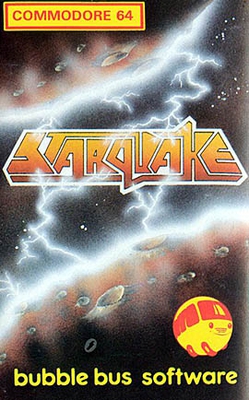
Starquake is an action-adventure platform game written by Stephen Crow for the ZX Spectrum and published by Bubble Bus Software in 1985. It was ported to the Commodore 64, MSX, Amstrad CPC, Atari 8-bit family, Tatung Einstein, the BBC Micro (1987) and IBM compatibles and Atari ST.

Operation Wolf is a light gun shooter arcade game developed by Taito and released in 1987. It was ported to many home systems.
Odin Computer Graphics were a Liverpool-based computer games developer who came to prominence in the mid-1980s with a variety of titles for the ZX Spectrum, Commodore 64 and Amstrad CPC home computers.
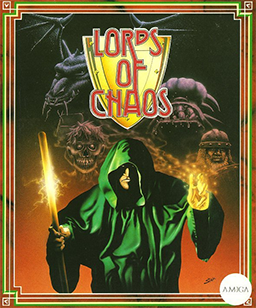
Lords of Chaos is a turn-based tactics tactical role-playing game published by Blade Software in 1990. It is the sequel to Chaos and an ancestor of the popular X-COM series of games, also written by Julian Gollop. In Lords of Chaos each player controls a wizard who can cast various magic spells. The spells have various effects, for example summoning other creatures, or damaging opposing creatures and wizards. The game can be played against a computer-controlled opponent or by up to four human players.

Underwurlde is a 1984 action-adventure platform video game in the Sabreman series by Ultimate Play the Game for the ZX Spectrum and Commodore 64. The player controls the adventurer Sabreman as he jumps between platforms in a castle and its caverns to find an escape past the exit guardians. Underwurlde features about 600 flip screen areas. Unlike other games of its time, Sabreman is not injured when touched by enemies and is instead knocked backwards. Underwurlde is the second game in the series, between Sabre Wulf and Knight Lore, and released shortly before the latter for the ZX Spectrum in late 1984. Another developer, Firebird, ported the game to the Commodore 64 the next year.

The Lords of Midnight is an epic fantasy video game combining aspects of wargames and graphic adventures, written by Mike Singleton and originally released in 1984 for the ZX Spectrum. Very well received from the beginning, it was soon converted for the Amstrad CPC and Commodore 64. The game featured an innovative 3-D effect that Singleton called landscaping, which served to bring the player into the game much more than usual. The Lords of Midnight is often named with Elite as among the top role-playing games of the 1980s. The player must destroy Doomdark, the evil Witchking who has locked the Land of Midnight in perpetual winter. There are multiple ways in which this can be achieved. It was followed by Doomdark's Revenge also in 1984, and Lords of Midnight: The Citadel in 1995.

The ZX Interface 2 is a peripheral from Sinclair Research for its ZX Spectrum home computer released in September 1983. It has two joystick ports and a ROM cartridge slot, which offers instant loading times. The joystick ports are not compatible with the popular Kempston interface, and thus do not work with most Spectrum games released prior to the launch of the ZX Interface 2. In addition, the pass-through expansion bus provided was stripped, only allowing a ZX Printer to be attached.

Pentagram is a ZX Spectrum and MSX video game released by Ultimate Play the Game in 1986. It is the fourth in the Sabreman series, following on from his adventures in Sabre Wulf, Underwurlde and Knight Lore. Similarly to Knight Lore it uses the isometric Filmation engine. The game was written by either Tim and Chris Stamper or a U.S. Gold programming team.
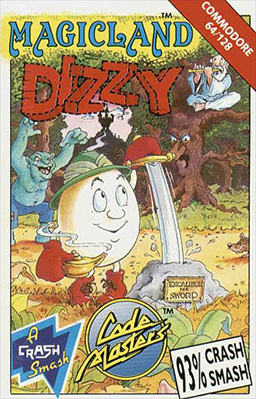
Magicland Dizzy is a platform adventure game published in Europe in 1990 by Codemasters for the ZX Spectrum, Commodore 64 and Amiga platforms. By 1992 there were also MS-DOS, Atari ST and Amstrad CPC versions available. It is the sixth game in the Dizzy series, and the fourth adventure-based Dizzy title. The story, set in a fantasy world called Magicland, follows on from the events of Fantasy World Dizzy, the previous adventure title. In Magicland Dizzy the player controls Dizzy, an egg-shaped character, who is trying to save six of his friends who have been placed under spells by the Evil Wizard Zaks.

Pyjamarama is a video game for the ZX Spectrum, Amstrad CPC, and the Commodore 64. It features Wally Week as the central character and is the second of a series of games featuring Wally and/or members of his family. It was published by Mikro-Gen. Starting in July 1986, Your Sinclair magazine published a monthly comic strip based on the character.
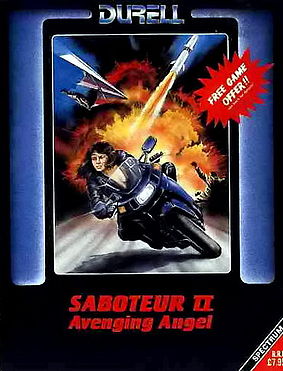
Saboteur II: Avenging Angel, also known as Saboteur 2, is an action-adventure game created by Clive Townsend and released by Durell Software in 1987 for the ZX Spectrum, Amstrad CPC, Commodore 64, and MS-DOS compatible operating systems. A sequel to 1985's Saboteur, the player controls a sister of Ninja from the first game on a mission to avenge his death. Saboteur II was one of the first action-adventure games with a female protagonist and was well received by critics.

Hydrofool is an isometric 3D action-adventure game released by FTL in 1987 for the ZX Spectrum and Amstrad CPC. It is the sequel to Sweevo's World. The game music was composed by Rob Hubbard, with the title track based on Abe Holzmann's "Blaze Away!"

Arc of Yesod is a video game by Odin Computer Graphics. It was published in 1985 for the ZX Spectrum and Commodore 64. It is the sequel to Nodes of Yesod.

Heartland is a platform game for the ZX Spectrum, Amstrad CPC, and Commodore 64 released by Odin Computer Graphics in 1986.

Rastan Saga, known as Rastan in North America, is a side-scrolling hack and slash arcade video game released by Taito in 1987. It was a critical and commercial success and was ported to home platforms.


















